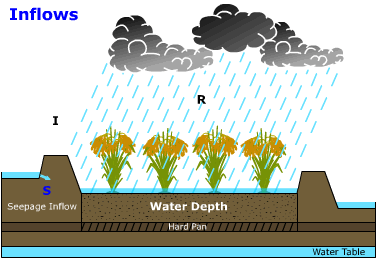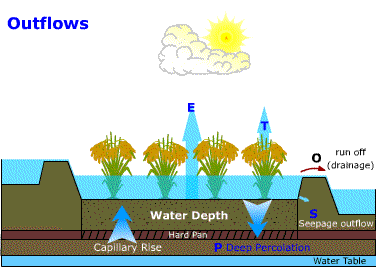![]() Describe water balance in the rice field
Describe water balance in the rice field
The water balance of a paddy consists of the following:
- Water inflows: irrigation, rainfall, and capillary rise.
- Water outflows: evaporation, transpiration, seepage, and percolation.
Click here to view water balance equation
Water contributes to the growth and development of plant and some in the process are considered as non productive water flows or losses from the field. Only transpiration ![]() is the productive water outflows or losses from the field.
is the productive water outflows or losses from the field.
By understanding the nature of the inflows and outflows of water, we will better address the importance of water management.
Water Inflow
Click on the play button to view water inflow process. Click on the letters to see the description


Water Outflow
Click on the play button to view water outflow process. Click on the letters to see the description

I – Irrigation can be a form of water pump from wells or from irrigation canals and rain water. This raises the level of ponded water in the paddies.
O – Over bund flow of excess water due to irrigation in a ricefield. This run off can flow into neighboring fields until it is lost in the drain.
E- Evaporation is the process of water leaving the paddies due to heat of the sun.
T – Transpiration is the process of giving off water vapor through the plants’ surface, it is the only productive flow in the system useful for plants.
S –Seepage is the sub surface flow of water underneath the buns or dike. Seepage losses can be recovered however maybe offset by seepage loss from another field located higher up, in a toposequence ricefield.
P - Percolation is the vertical flow of water to below the root zone. The rate of percolation is dependent on the soil structure, texture, bulk density, mineralogy, organic matter content, and salt type and concentration.
C – Capillary rise, when for some reason, fields are not flooded, water capillary may rise and reach into the rootzone and provide extra water to the crop.

It is important to reduce nonproductive outflows in the ricefield while satisfying the transpiration requirements of the crop.
Having understood the different water inflows and outflows in the ricefield we can now proceed in describing the role of groundwater in providing water to rice plants.